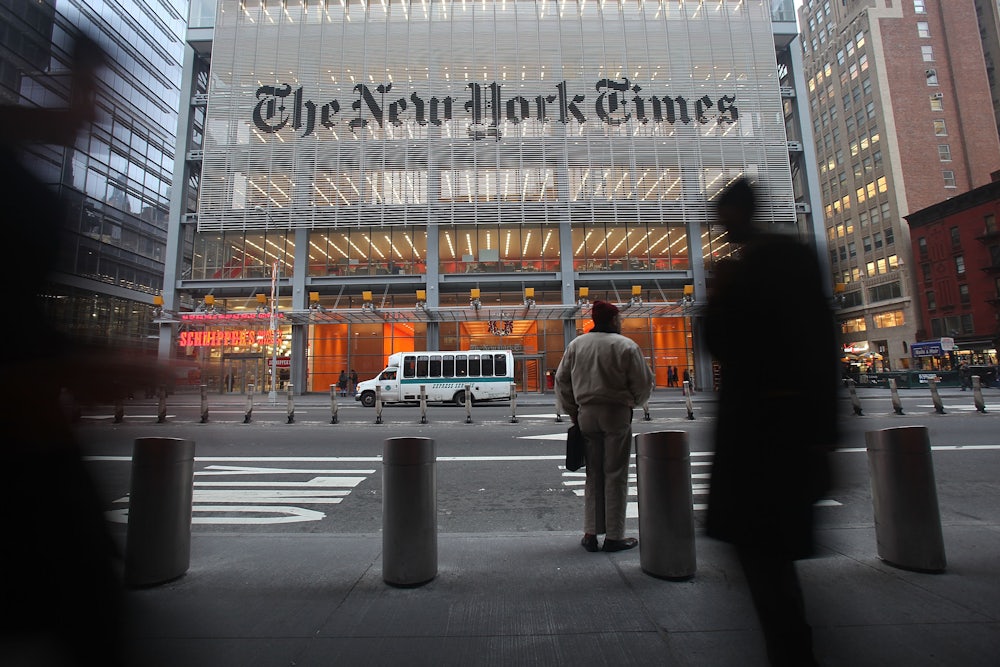For years, conservative and centrist columnists have been depicting college campuses as if they were the settings of horror movies. A virus is incubating and spreading. Every year, more and more people are infected with wokeness. The stakes might be small—a misconstrued story about Chinese food and Oberlin College is frequently cited—but, these writers argued, something much scarier is afoot. Every year, more snowflakes enter the real world, spreading cancel culture through every strata of society. Soon, the whole world will be a campus.
The furor following The New York Times’ publication of Senator Tom Cotton’s op-ed was, for many of these writers, a vindication. During a town hall meeting on Friday at the Times, in which staffers voiced their outrage and concerns, op-ed columnist Bari Weiss took a victory lap. She tweeted that the debates about political correctness on campus—the debates she had warned about—were now on the front door of the country’s leading newspaper, as well as “other publications and companies across the country.” New York magazine columnist Andrew Sullivan has spent the last week tweeting variations of “We all live on campus now,” the headline of a column he wrote in 2018. National Review was somehow even more histrionic: The headline to a Tuesday David Harsanyi column about the Cotton op-ed described recent events without irony as a “Cultural Revolution.” The big issue for these writers wasn’t systemic racism or police brutality. It was the return of Maoism.
These arguments rest on the idea that liberal democracy is under threat—from an increasingly authoritarian right wing, sure, but also from an increasingly dogmatic left. Sullivan has recirculated a 2019 diatribe about Ibram X. Kendi’s bestseller How to Be an Anti-Racist, whose recent presence on bestseller lists he has bemoaned. “They seem not to genuinely believe in liberalism, liberal democracy, or persuasion. They have no clear foundational devotion to individual rights or freedom of speech,” he wrote.
Despite all the paeans to liberal democracy, Sullivan and Weiss’s project is a small one. Other anxieties are apparent. For decades, the opinion pages were safe spaces for white, reactionary writers. These writers are lashing out at a loss of impunity and a rise in editorial standards that are making opinion journalism stronger.
While the Times was dealing with the aftermath of the Cotton op-ed, Sullivan was dealing with his own problems. A column from “Cockburn” in The Spectator cited a tweet from Sullivan announcing his weekly column wouldn’t be appearing. The reason? “Presumably Sullivan’s editors are frightened that he might make the radically bourgeois point that looting and violence are wrong,” Cockburn wrote. Later in the column he noted, “Sullivan, a source close to New York magazine reveals, has to have his work vetted by sensitive junior editors to make sure it doesn’t trigger them. If it passes their sniff testing, it can be published.” Maoism!
Over the weekend, in a since-deleted tweet, former New York editor Max Read noted that he was one of the “junior editors” who had once pointed out something that needed to be changed in a Sullivan column (in this instance, Sullivan had cited a fake antifa social media account). Brian Feldman, a writer at New York, tweeted that it marked “the only time I’d ever heard of Sullivan’s column getting anything resembling substantive pushback from editors at all.” (On Sunday, Sullivan retweeted a tweet that falsely claimed that former Washington Post reporter Wesley Lowrey was “fired” from the paper and “lied” about it. Sullivan apologized after being called out.)
Cockburn’s column is revealing. For Sullivan and his defenders, free speech and liberalism mean that he gets to publish whatever he wants, without dissent or intervention. Pushing back or pointing out factual errors—key parts of the editorial process—are, for Sullivan and Co., a threat to the foundations of Western civilization.
In the polemic about “cultural revolution,” there is quite a bit of talk about the need for debate. For many on the right, “debate me” is the ultimate comeback, proof of one’s toughness and conviction and allegiance to liberal values. But the writers most committed to warning America about the barbarians at the gate are the ones who appear to be living in a bubble. Weiss’s tweet thread about campus culture coming to the Times was not factually accurate, particularly its claim that the controversy boiled down to a generational battle between those under 40 who believe in “safetyism” and those over 40 who believe in free speech. Rather than take criticism of her comments to heart, she has spent the last several days retweeting praise. Bret Stephens, who has written extensively about free speech and campus culture, got called out at the same time for repeatedly tattling on co-workers who had critiqued his columns.
Far from a reluctance to engage—or, to use Weiss’s words, a desire for “safety”—the disagreement with Cotton’s op-ed was rooted in difficult, complicated subjects: creeping fascism, violent racism, a Republican Party that has itself shown contempt for liberal democracy and its norms. Weiss and Sullivan portray themselves as crusaders against narrow-minded, thin-skinned millennials and are so convinced of their own righteousness that they don’t have to listen to, let alone respect, their colleagues. Why bother? These people, after all, are safety-obsessed snowflakes, unwilling to reckon with hard truths.
